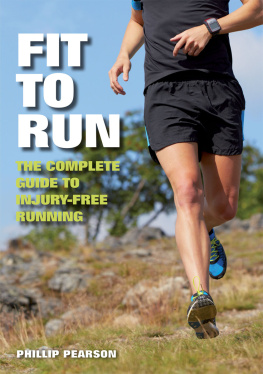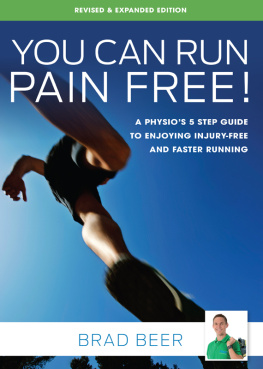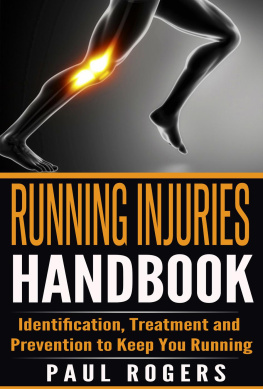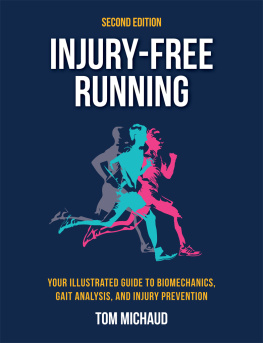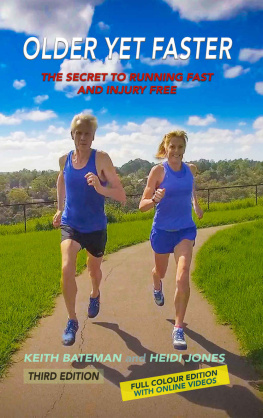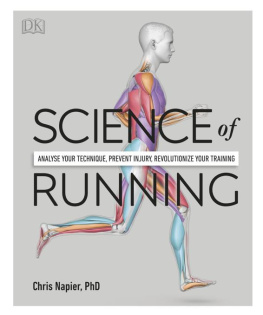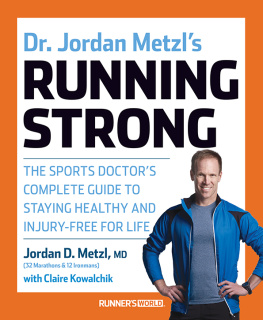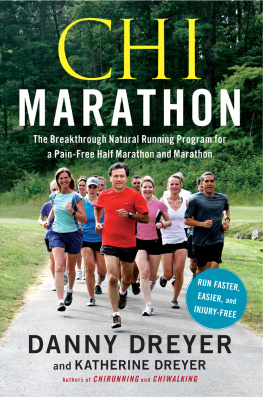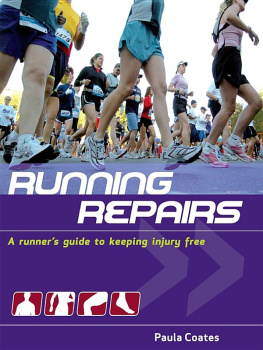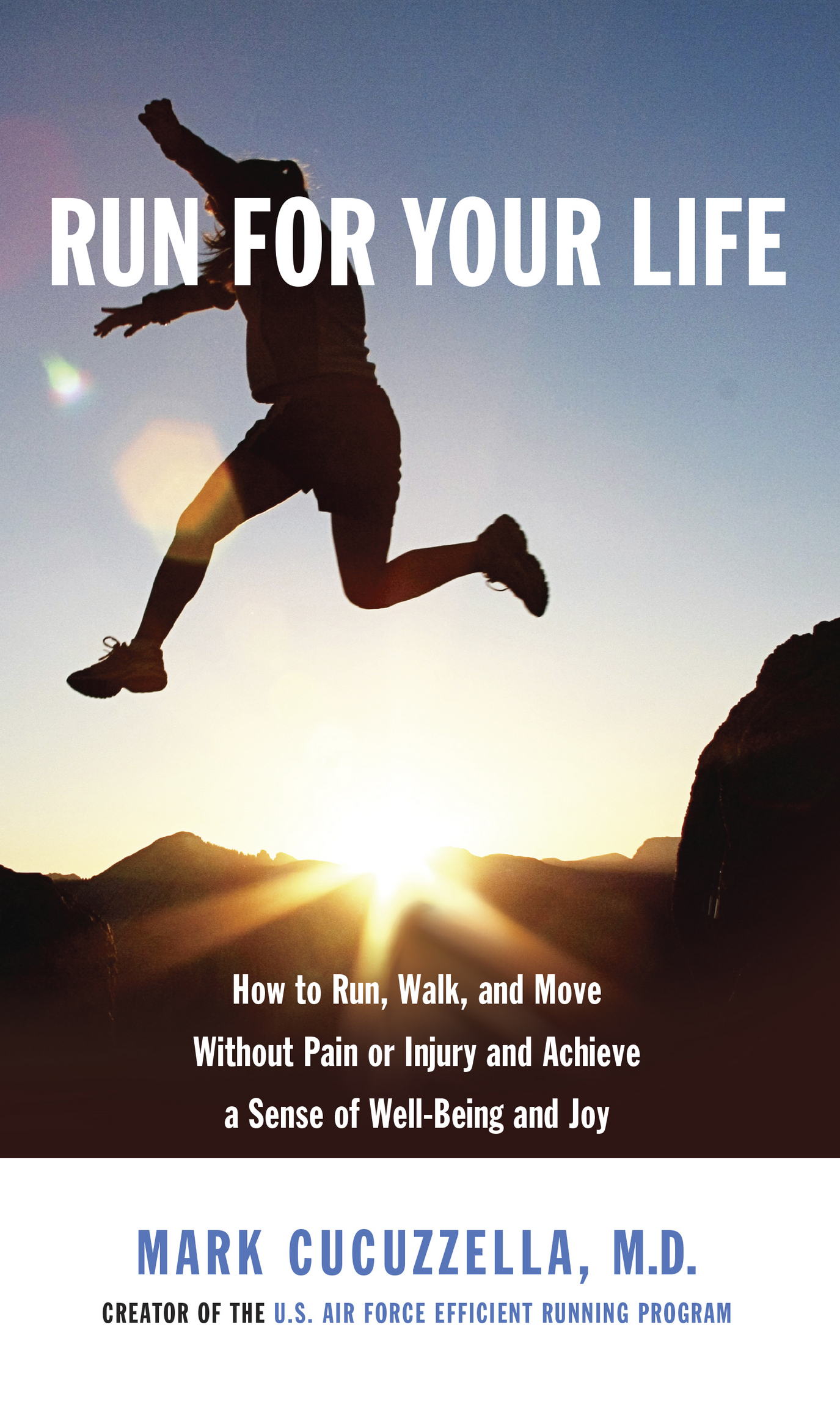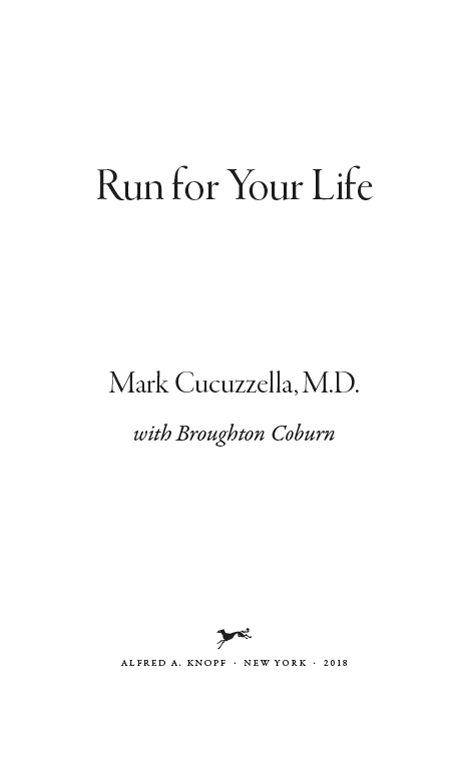PUBLISHED BY ALFRED A . KNOPF
All rights reserved. Published in the United States by Alfred A. Knopf, a division of Penguin Random House LLC, New York, and distributed in Canada by Random House of Canada, a division of Penguin Random House Canada Limited, Toronto.
Knopf, Borzoi Books, and the colophon are registered trademarks of Penguin Random House LLC.
Names: Cucuzzella, Mark, author.
Title: Run for your life / Mark Cucuzzella, M.D.
Description: First edition. | New York : Alfred A. Knopf, 2018. | Includes bibliographical references and index.
Identifiers: LCCN 2017061533 (print) | LCCN 2017056684 (ebook) | ISBN 9781101946305 (hardback) | ISBN 9781101946312 (ebook) Subjects: LCSH: RunningTraining. | RunningPhysiological aspects. | Running injuriesPrevention. | BISAC: HEALTH & FITNESS / Exercise. | SELF-HELP / General. | SPORTS & RECREATION / Running & Jogging. Classification: LCC GV1061.5 (print) | LCC GV1061.5 .C83 2018 (ebook) | DDC 613.7/172dc23
Introduction
If we could give every individual the right amount of nourishment and exercise, not too little and not too much, we would have found the safest way to health.
HIPPOCRATES
In college, a persistent dream captured many of my waking hours: to run with effortless, efficient grace.
But first, I had to figure out how to run without pain.
Getting to that point wasnt easy, nor did it happen quickly. I had to scrap my preconceptions and retool the way I stood, walked, and eventually ran. My roundabout path took me to medical school, to active-duty Air Force, to the University of Colorado, and to a rural West Virginia family medicine practicevia twenty-four Boston Marathons. Along the route, I picked up more tasksas the U.S. Air Forces running coach, as a prof at the West Virginia University School of Medicine, as a race director, and as the owner-operator of an award-winning shoe store.
Eventuallyand as something of a surpriseI reached a sustained high level of pain-free physical performance, accompanied by a remarkable sense of well-being. This sense of wellness is there for the learning and the taking. It requires little more than getting outsidemoving, exercising, running, walking, and enjoying physical activity together.
The emphasis is on the together part. More important than any running achievements, Im most proud of having initiated several community school and health programs, and founding one of the eastern seaboards most popular fun runs. Throughout, my goal has been to help boost fitness and health for people of every age, and Ive been encouraged by the testimonials from near-countless injured and sedentary folks who are now running, playing, and exerting with joy.
Distressingly, Ive seen too many dedicated runners become former runners. And Ive seen many nonrunners never begin. Too often in my medical practice I hear the phrase I hate to run or I cant.
It doesnt need to be this way.
However odd it sounds, health care professionals are often complicit in unhealthy behavior and outcomes, by providing treatments that dont offer lasting solutions. When treating runners, we tend to ignore prehab, the preventive solution: learn proper posture, strengthen the core muscles, settle into a good running pace, build endurance, understand mobility and efficiency of movement, and indulge a sense of contentment. Add to that restful sleep, good nutrition, sufficient recovery time, and even a sense of community, and you are solidly on the path to becoming stronger, to preventing injury, and to appreciating the magical gift of the human form. Simplicity of style begets efficiency of function.
The chapters of this book, and the exercises that conclude each of them, are designed to fit into your busy life. Nowadays, I cant imagine lining up for marathons and ultra distances without my secret weapon: the techniques that are summarized in this humble volume. By applying these principles, I now hold the worlds longest active streak (thirty years) for consecutive years of running marathons in under 3 hours. At ages forty and forty-four, I won the Air Force Marathon outright in 2:31 and 2:38, and at age forty-four I ran the Boston Marathon in 2:34. Ive also dabbled in ultra-marathons, including a first-place Masters finish in the competitive JFK 50 Mile run. My times are slowing a tad now that Ive reached fifty (and my life becomes overfilled), but I anticipate many more years of running enjoyment. You can, toowhatever your performance goals.
Youre invited to be my companion on this exhilarating path of self-discovery. For me, the discovery and learning continuedaily, at full throttleas I devour emerging information on diet and diabetes, on our microbiome, on stress and stress relief, on the benefits of nature, and on much more. Simply put, we need to grab our kids and our old folks, get outside, and build movement, healthful food, and joy into our communities. Its not just about running. If you prefer to walkor garden, or hike, or play golfmost of what youll find here applies to you, too. My own path to these discoveries entailed endless trial and error. By reading this book, youll leapfrog my struggle and experimentation to find an easier and faster way to a fit, healthy life. Im grateful for the chance to share with you the secrets that I have learned.
AN ULTRA-MARATHON-LONG STORY
For me, running didnt happen in a straight line. I began to run at the age of thirteen, and often was the fastest in my age group. Modest successes generated enough positive reinforcement to keep me going, harder and faster. I competed through high school, and in the mid-1980s I raced for the University of Virginia.
But triumphs were well seasoned with pain, injuries, setbacks, surgeries, and lengthy rehab. I underwent my first knee surgery at age fifteen, and spent most of my high school years swimming laps at the YMCA instead of running. At one point, as a side effect of prescribed anti-inflammatories, I lost half my blood from an intestinal ulcer.
In 2000, arthritis in my big toes nearly ended my running career. Thats when I attempted to qualify for the 2000 Olympic Trials. I had run the Military World Championship Marathon in 2:24, on a steamy hot day in Rome and with marginal training. Surely I could finish the racetrack-like Chicago Marathon in 2:22, the time needed to qualify. For six months I devoted all my spare time to training for the 1999 Chicago race.
Pain dictates your level of effort, and your joy. And in the six months preceding the Chicago Marathon, I hadnt strung together a single week of pain-free training. Plantar fasciitis nagged me with every step, even when walking.
I lined up, anyway, with the other competitors. I forced myself to maintain a pace of 5:20 for each of the first twenty miles, then began to slow. My final time of 2 hours and 24 minutes was respectable, but a couple of minutes shy of the qualifying time.
My next event was surgeryto relieve (some) of the pain in my foot. But the arthritis left my big toe joints inflexible and crooked. Along the way, I acquired an array of arch supports, orthotics, and oddly designed shoes, which I offered (with prayers for deliverance) to my altar of pain-free running. Doctors consistently told me to quit running and take up another activity. But I could find nothing as convenient, relaxing, and enjoyablenothing that delivered the same feeling of overall freedom.


